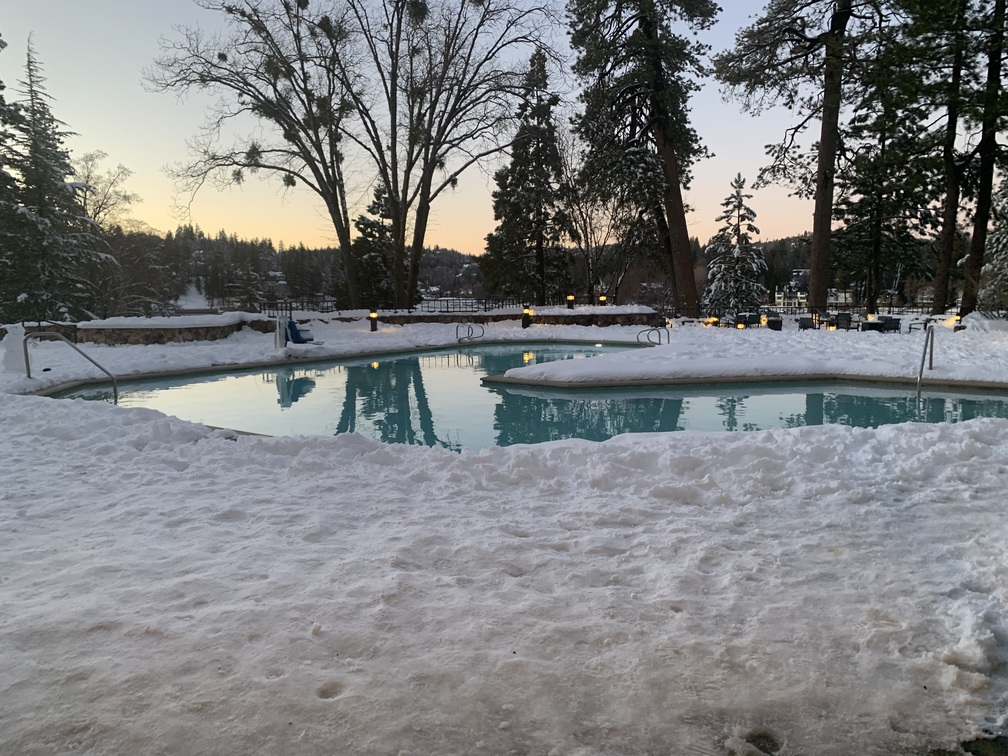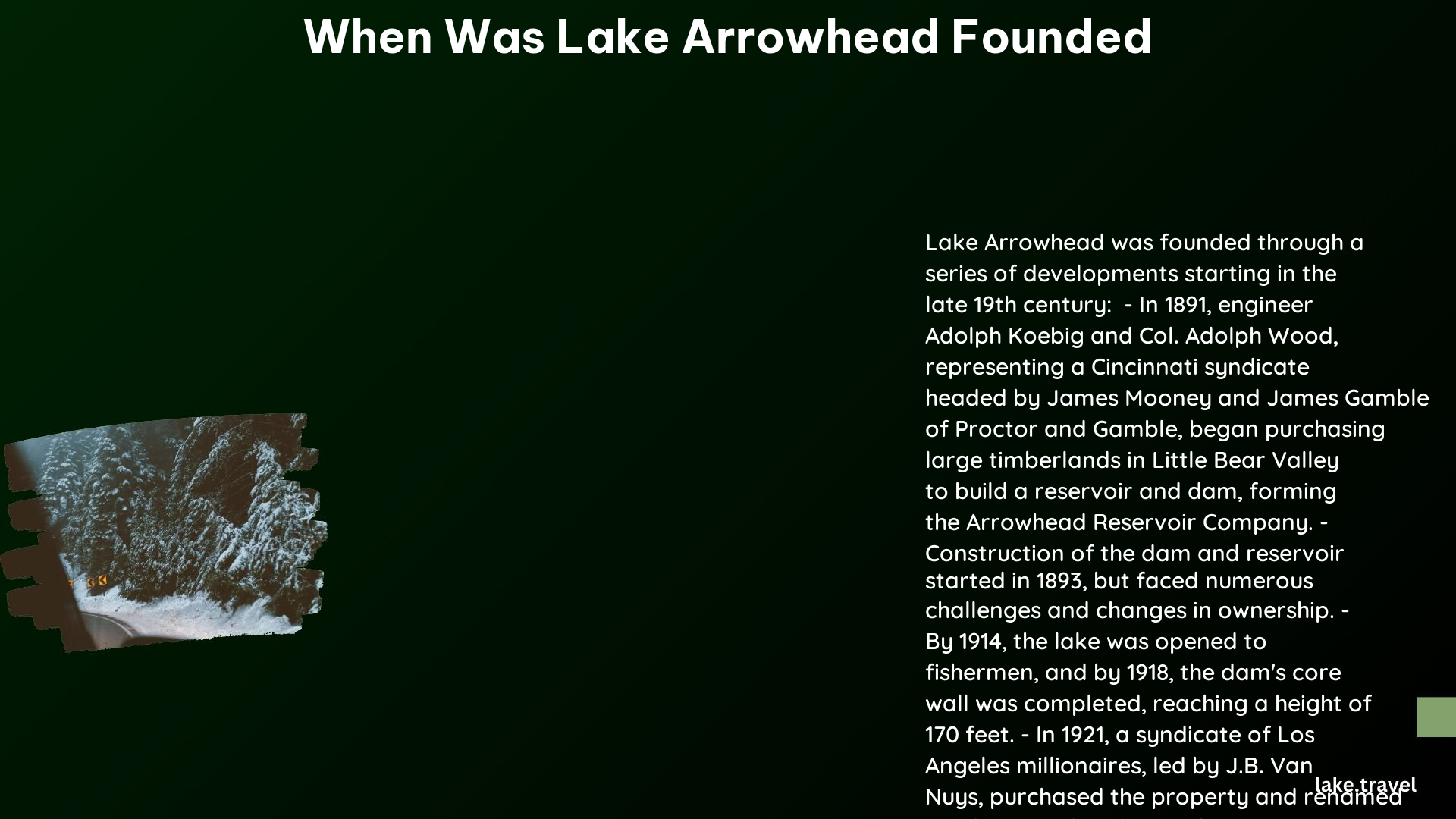Lake Arrowhead’s founding spans several key events from 1890 to 1922. The Arrowhead Reservoir Company formed in 1890 to create a water reservoir. Construction began in 1893 but faced delays. In 1921, the property was sold for recreational development. The Lake Arrowhead Village officially opened on June 24, 1922, marking the culmination of the founding process.
What Are the Key Dates in Lake Arrowhead’s Founding?

Lake Arrowhead’s founding is not tied to a single date but rather a series of significant events:
- 1890: Formation of the Arrowhead Reservoir Company
- 1893: Initial dam construction begins
- 1901: Dam construction resumes after delays
- 1921: Property sold to Arrowhead Lake Company for recreational development
- June 24, 1922: Official opening of Lake Arrowhead Village
Who Were the Original Inhabitants of Lake Arrowhead?

The Lake Arrowhead area was originally inhabited by Native American tribes:
- Paiute Indians: Used the mountains for hunting grounds
- Serrano Indians: Lived near Little Bear Valley
These tribes significantly influenced the early development and settlement of the area through their interactions with white settlers.
What Is the Detailed Timeline of Lake Arrowhead’s Development?
The development of Lake Arrowhead can be traced through the following timeline:
- 1826: First white man enters Little Bear Valley
- 1850s: Mormon settlers build mountain road and harvest lumber
- 1890: Arrowhead Reservoir Company forms
- 1893-1901: Initial dam construction and delays
- 1905: Dam partially completed
- 1914: Lake opens to fishermen, lakefront lots sold
- 1918: Dam corewall curtain finished, height raised to 170 feet
- 1921: Property sold to Arrowhead Lake Company
- June 24, 1922: Lake Arrowhead Village opens
- June 23, 1923: Arlington Lodge opens
- 1920s-1930s: Development of Norman-styled village and amenities
- 1960: Lake Arrowhead Development Company forms, builds golf course
- 1967: Merger with Boise Cascade Corporation
- 1971-1973: Ownership changes and reacquisition by Boise Cascade
- 1974: New dam construction and creation of Papoose Lake
What Amenities Were Established During Lake Arrowhead’s Founding?
During its founding period, Lake Arrowhead established several key amenities:
| Amenity | Description |
|---|---|
| Hotels | Arlington Lodge, Village Inn, North Shore Tavern |
| Golf Course | Initially 9 holes, expanded to 18 in 1960 |
| Village | Norman-styled with dance pavilion, outdoor movie theater, restaurant |
| Beach | Public beach area with bath houses |
| Recreational Activities | Boating, fishing, skiing |
Over time, these amenities evolved and expanded:
- Golf course expansion to 18 holes in 1960
- Extensive residential development in Arrowhead Woods
- Infrastructure improvements including a new dam and water filtration plant
How Did the Original Purpose of Lake Arrowhead Change?
The original purpose of Lake Arrowhead underwent a significant transformation:
- Initial Purpose: Water reservoir for irrigation
- 1890: Arrowhead Reservoir Company formed to create a water source for San Bernardino Valley
-
1893-1905: Dam construction for irrigation purposes
-
Shift to Recreation:
- 1914: Lake opened to fishermen, indicating early recreational use
- 1921: Sale to Arrowhead Lake Company marks official shift to recreational focus
-
1922: Opening of Lake Arrowhead Village solidifies recreational purpose
-
Residential Development:
- 1960s: Subdivision of residential tracts begins
- Ongoing: Continued development of Arrowhead Woods and surrounding areas
This transformation from an irrigation project to a recreational and residential destination shaped Lake Arrowhead’s identity and development trajectory.
What Challenges Were Faced During Lake Arrowhead’s Founding?
The founding of Lake Arrowhead encountered several challenges:
- Economic Setbacks:
- Four-year depression in the 1890s delayed initial construction
-
Changes in ownership caused further delays
-
Technical Difficulties:
- Dam construction complexities led to extended timelines
-
Safety concerns about the dam in the 1970s necessitated new construction
-
Cultural Conflicts:
- Interactions between Native American tribes and white settlers sometimes led to conflicts
-
A skirmish occurred due to advances made by a white man towards a Serrano Indian maiden
-
Ownership Changes:
- Multiple changes in ownership from 1890 to 1970s affected development plans
-
1971-1973 saw rapid ownership changes and financial difficulties
-
Environmental Considerations:
- Transition from irrigation to recreational use required different environmental management
- Creation of Papoose Lake in 1974 to address dam safety concerns
These challenges shaped the development process and influenced the ultimate form and function of Lake Arrowhead.
How Has Lake Arrowhead’s Founding Influenced Its Current Identity?
Lake Arrowhead’s founding period has significantly influenced its current identity:
- Recreational Focus:
- The shift from irrigation to recreation in the 1920s established Lake Arrowhead as a premier resort destination
-
Current tourism industry builds on the foundation laid during founding years
-
Architectural Character:
- Norman-styled village developed in the 1920s-1930s continues to define Lake Arrowhead’s aesthetic
-
Historic buildings like the Arlington Lodge contribute to the area’s charm
-
Residential Community:
- Early lakefront lot sales and later residential developments shaped Lake Arrowhead into a desirable living area
-
Arrowhead Woods, developed from the 1960s, remains a key residential zone
-
Outdoor Activities:
- Founding-era focus on boating, fishing, and skiing established Lake Arrowhead as an outdoor recreation hub
-
These activities continue to be central to the area’s appeal
-
Infrastructure:
- Early investments in dams, roads, and utilities laid the groundwork for modern infrastructure
-
Ongoing improvements build on this historical foundation
-
Cultural Heritage:
- Native American history and early settler interactions contribute to the area’s rich cultural narrative
- This heritage is often celebrated and remembered in local events and historical sites
The founding period’s decisions and developments continue to shape Lake Arrowhead’s character, economy, and community, creating a unique blend of historical charm and modern amenities.
References:
1. Lake Arrowhead History – Village Cove
2. Our History | Lake Arrowhead Resort and Spa
3. History – Lake Arrowhead Communities Chamber of Commerce
